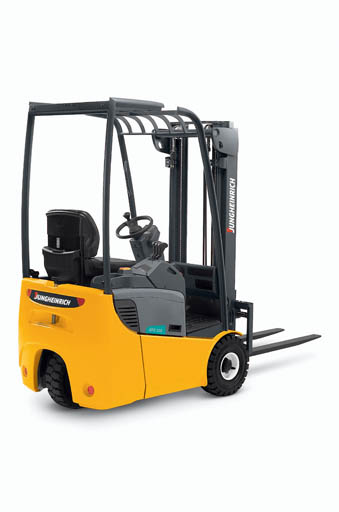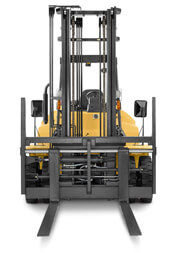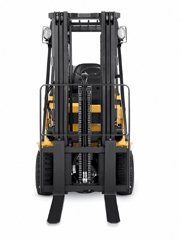Forklift Mast Types
This helpful resource explains the various types of forklift masts and how to choose the right mast for your material handling environment.
Forklift mast types are an important consideration when choosing the right lift truck for your application. The vertical space in your facility, height of racking and size of the load handled are each important factors when selecting the right mast your forklift. The below article will help give you general knowledge on how a mast functions, while also covering the different mast types available. If you would like further help choosing the right forklift for you, contact your local lift truck dealer here.
What is a Forklift Mast?
The mast is the system in a forklift that performs load lifting.
The mast consists of a fork and an elevation mechanism, associated with the lift truck’s hydraulic assembly. Two systems of classification have arisen to describe a forklift truck's mast in detail. An operating manual may classify the mast either by the lift mechanism, or by the number of mast "sections". Regardless of the terminology, it’s important to know the difference in forklift mast types when choosing the right forklift mast for your facility.Standard And Full Free Lift Forklifts
The mast makes a big difference in the functionality of a forklift within a particular environment. The single mast elevates the inner mast section along with the load. It requires additional overhead space to allow for the channels of the mast to raise higher than the load. This can be problematic in narrow aisles and tight quarters at lower forklift lift heights.Other types of forklifts, designed for use within restricted overhead spaces are called "full free lift" masts. They allow the forks to lift without raising the mast channels. These forklifts allow an operator to maneuver more easily in areas with limited available overhead space. Typically, the necessity of placing a hydraulic mechanism in the center of a full free lift mast means an operator will not have as much visibility as they would in a standard forklift. This should be taken into consideration depending on the application, type of product being moved and general work requirements.
HOW MANY FORKLIFT MAST TYPES ARE THERE?
Today, forklift operators typically depend upon any one of four different forklift mast types. Manufacturers do not always use uniform terminology to refer to these components. One company may describe its masts in terms of the lift mechanisms, while another may base its descriptions of masts on the number of mast sections.1. Simplex Mast
Usually these forklifts can lift loads only limited distances. For instance, they may lift cargo onto the back of a truck.

This common type of standard forklift mast employs an arrangement of a stationary outer rail and a sliding inner rail with chains to lift a carriage and forks. The maximum extension of the inner rails will limit the height of load lifting.
2. Duplex Mast
This mast is the optimal choice when loads need to be double-stacked and the lift truck will not be placing such loads into high racking. Material handling application examples include freight cross-docking and manufacturing component delivery operations. (Also known as: Duplex Upright or Two-Stage Free-Lift Mast).

This type of mast has a hydraulic cylinder located in the center of the mast assembly that helps push loads upwards, enabling the load to rise while the mast itself remains stationary. Once the carriage reaches the top of the inner rails, two supporting side rails complete the lifting process.
3. Triplex Mast
These widely used masts have become the most popular recently. They enable loading and unloading at higher elevations than duplex masts.

A Triplex mast differs from the Duplex because it includes two sliding rails plus a single stationary rail: it is often found on a reach truck as it can extend a load further to reach greater distances. A large hydraulic ram in the center of the mast assembly performs most of the lifting of the forks and carriage. Secondary hydraulic cylinders lift the middle sections and a chain system, which pulls the inner section and the carriage when the mast is fully extended. (Other terms for this type of mast: Third Stage Mast, FSV Mast, Triple Mast, Triple Stage Upright).
4. Quad Mast
As the name suggests, this complex mast depends on four sets of rails and chains to move loads. Forklift operators typically require advanced training in order to use this type of mast, which reaches much higher elevations and may have restricted visibility.
A Quad mast can provide full free lift as it operates similarly to the Triplex. However, its powerful hydraulic secondary cylinder rails and chains permit extra extension. (Also known as: QFV Mast, or Four Stage Mast).
Additional Resources
- Anatomy of a Forklift
- Glossary of Forklift Terminology and Definitions
- Choosing The Right Forklift Type









